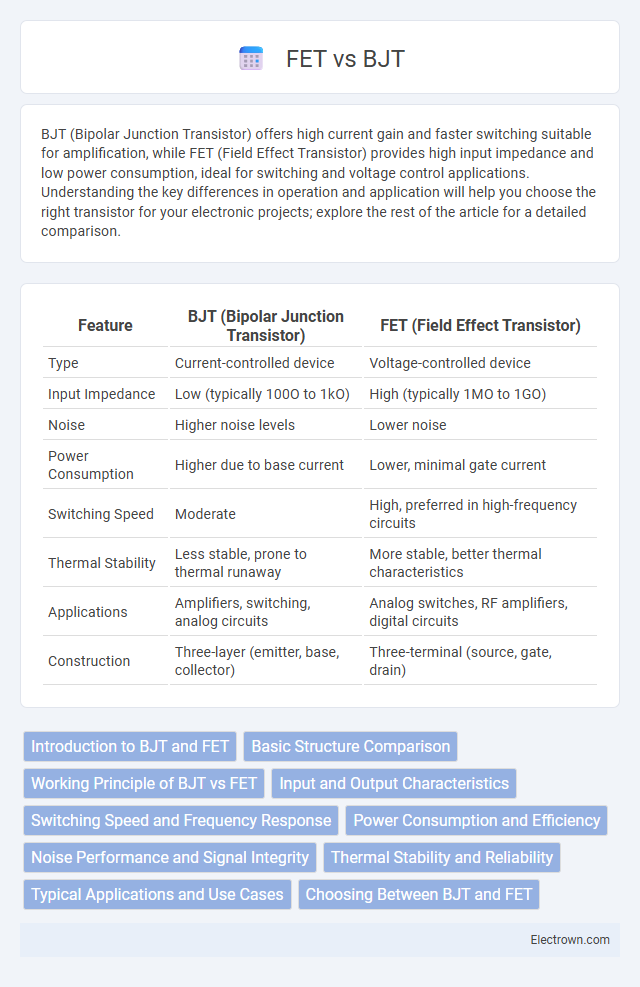BJT (Bipolar Junction Transistor) offers high current gain and faster switching suitable for amplification, while FET (Field Effect Transistor) provides high input impedance and low power consumption, ideal for switching and voltage control applications. Understanding the key differences in operation and application will help you choose the right transistor for your electronic projects; explore the rest of the article for a detailed comparison.
Table of Comparison
| Feature | BJT (Bipolar Junction Transistor) | FET (Field Effect Transistor) |
|---|---|---|
| Type | Current-controlled device | Voltage-controlled device |
| Input Impedance | Low (typically 100O to 1kO) | High (typically 1MO to 1GO) |
| Noise | Higher noise levels | Lower noise |
| Power Consumption | Higher due to base current | Lower, minimal gate current |
| Switching Speed | Moderate | High, preferred in high-frequency circuits |
| Thermal Stability | Less stable, prone to thermal runaway | More stable, better thermal characteristics |
| Applications | Amplifiers, switching, analog circuits | Analog switches, RF amplifiers, digital circuits |
| Construction | Three-layer (emitter, base, collector) | Three-terminal (source, gate, drain) |
Introduction to BJT and FET
Bipolar Junction Transistors (BJTs) are current-controlled devices that use both electron and hole charge carriers to amplify signals, making them suitable for high-gain applications. Field Effect Transistors (FETs) are voltage-controlled devices relying on an electric field to control current flow, offering high input impedance and low power consumption. Your choice between BJT and FET depends on factors like switching speed, power efficiency, and circuit requirements.
Basic Structure Comparison
BJT (Bipolar Junction Transistor) consists of three layers of semiconductor material forming two p-n junctions, typically arranged as emitter, base, and collector, while FET (Field-Effect Transistor) features a single type of semiconductor with a gate controlling current flow through a channel between the source and drain. The BJT operates using both electron and hole charge carriers, providing high current gain but with higher power consumption, whereas the FET relies on an electric field to control conductivity, resulting in high input impedance and low power dissipation. Understanding these basic structural differences helps you choose the right transistor type for amplifying signals or switching applications.
Working Principle of BJT vs FET
BJT (Bipolar Junction Transistor) operates based on the injection and control of minority charge carriers, where current flow between the emitter and collector is regulated by the base current. FET (Field Effect Transistor) controls current through an electric field that modulates the conductivity of a semiconductor channel between the source and drain terminals, using voltage applied to the gate. Your choice depends on whether you need current-driven or voltage-driven operation for efficient signal amplification or switching.
Input and Output Characteristics
Bipolar Junction Transistors (BJT) have a high input current with low input impedance, making them current-controlled devices, while Field Effect Transistors (FET) feature high input impedance and require negligible input current, operating as voltage-controlled devices. BJT output characteristics display a linear relationship between collector current and collector-emitter voltage in the active region, whereas FETs exhibit a saturation region where the drain current remains relatively constant despite increases in drain-source voltage. Understanding these input and output differences helps you choose the right transistor for your amplification and switching requirements.
Switching Speed and Frequency Response
BJT transistors generally offer faster switching speeds due to their minority carrier operation, making them suitable for high-frequency applications with rapid transitions. FETs, relying on majority carriers, provide superior frequency response and low noise performance but may have slower switching times in comparison. Your choice between BJT and FET will depend on the specific requirements for switching speed and operational frequency in your electronic circuit.
Power Consumption and Efficiency
BJT transistors typically consume more power due to continuous base current flow, reducing overall efficiency compared to FETs, which rely on voltage control and minimal gate current. FETs exhibit higher power efficiency in low-power and high-frequency applications, making them ideal for battery-operated devices. Your choice between BJT and FET impacts the energy efficiency and thermal management of your electronic circuit design.
Noise Performance and Signal Integrity
Bipolar Junction Transistors (BJTs) generally exhibit lower noise levels in low-frequency applications due to their higher transconductance, making them suitable for audio and low-noise amplifier circuits. Field-Effect Transistors (FETs) offer superior signal integrity at high frequencies because of their high input impedance and low gate leakage current, which reduces capacitive loading and minimizes signal distortion. Noise figure and harmonic distortion are critical metrics where BJTs perform better under low-signal conditions, while FETs excel in preserving signal fidelity in RF and microwave frequency ranges.
Thermal Stability and Reliability
BJT (Bipolar Junction Transistor) devices exhibit lower thermal stability compared to FETs (Field-Effect Transistors) due to their higher sensitivity to temperature variations, often leading to thermal runaway if not properly managed. FETs provide superior thermal reliability because their gate voltage controls conductivity without significant temperature-dependent gain fluctuations, enhancing performance in high-temperature environments. Your choice favors FETs for applications demanding robust thermal stability and long-term reliability under variable thermal conditions.
Typical Applications and Use Cases
Bipolar Junction Transistors (BJTs) are commonly used in applications requiring high current gain and fast switching, such as in amplifiers, audio devices, and switching power supplies. Field Effect Transistors (FETs), especially MOSFETs, excel in low-noise signal amplification, digital circuits, and power management systems due to their high input impedance and fast switching capabilities. BJTs are preferred for analog signal processing, while FETs dominate in integrated circuits and high-efficiency power electronics.
Choosing Between BJT and FET
Choosing between BJT and FET depends on application requirements such as switching speed, power efficiency, and input impedance. BJTs offer high gain and fast switching suitable for amplification and low-voltage circuits, while FETs provide high input impedance and low noise ideal for voltage-controlled applications and sensitive analog circuits. Optimal selection involves balancing parameters like current handling, thermal stability, and frequency response to match specific circuit needs.
BJT vs FET Infographic

 electrown.com
electrown.com